Services on Demand
Journal
Article
Indicators
-
 Cited by SciELO
Cited by SciELO -
 Access statistics
Access statistics
Related links
-
 Cited by Google
Cited by Google -
 Similars in
SciELO
Similars in
SciELO -
 Similars in Google
Similars in Google
Share
CT&F - Ciencia, Tecnología y Futuro
Print version ISSN 0122-5383On-line version ISSN 2382-4581
C.T.F Cienc. Tecnol. Futuro vol.2 no.3 Bucaramanga Jan./Dec. 2002
1Ecopetrol - Instituto Colombiano del Petróleo, A.A. 4185 Bucaramanga, Santander, Colombia.
2Ecopetrol - AEX, Calle 37 N° 8 - 43, 8° Piso, Bogotá, D.C., Colombia
e-mail: arangel@ecopetrol.com.co
ABSTRACT
The Patia basin is an exploration frontier area of approximately 5000 km2 located in southwestern Colombia. Seventy samples from 6 outcrop sections and one oil sample from the Matacea Creek seep were submitted for geochemical analyses. These analyses provide a basis to better assess the petroleum potential of this frontier area. Organic carbon content and Rock-Eval pyrolysis indicate that the Chapungo Sequence of Late Cretaceous age and the Chimborazo Formation of Eocene age have the higher petroleum source potential among the studied units. Petrographic evidence suggests that the heat effect of igneous intrusions account for the high maturity of some of the sampled intervals. Bulk and molecular parameters indicate that the oil sample of the Matacea Creek seep has been biodegraded, but there is also evidence of a recharge of the oil to the surface. Biomarker data indicates that the Chimborazo Formation is the unit that displays the best correlation with the Matacea Creek oil. The lack of a perfect match between the oil seep and the Chimborazo extracts might be the result of biodegradation or the existence of more proximal facies of the Chimborazo Formation, not sampled in this survey. The Matacea Creek oil seep is proof of a petroleum system.
Keywords: Patía Basin, oil seep, organic geochemistry, biomarker.
RESUMEN
La cuenca de Patía es un área de frontera exploratoria con 5000 km2 localizada en la porción suroeste de Colombia. Setenta muestras de roca de afloramientos y una muestra de crudo del rezumadero de la Quebrada Matacea fueron sometidas a análisis geoquímicos. Estos análisis permitieron una mejor evaluación del potencial petrolífero de esta área de frontera. Análisis de carbono orgánico y pirólisis indican que la Secuencia Chapungo de edad Cretáceo tardío y la Formación Chimborazo de edad Eoceno poseen los mejores potenciales para generación de petróleo entre las muestras estudiadas. Evidencias petrográficas sugieren que el efecto térmico de intrusiones ígneas es responsable por el alto grado de madurez de algunos de los intervalos muestreados. Parámetros globales y moleculares indican que la muestra de crudo del rezumadero de la Quebrada Matacea ha sido biodegradada, pero también hay evidencia de una recarga de crudo en la superficie. Datos de biomarcadores indican que la Formación Chimborazo es la unidad que presenta la mejor correlación con el crudo de la Quebrada Matacea. La falta de una correlación perfecta entre el crudo y los extractos de Chimborazo puede deberse a la biodegradación o a la existencia de facies más proximales de la Formación Chimborazo, no muestreadas en este estudio. El rezumadero de la Quebrada Matacea es una prueba de la existencia de un sistema petrolífero en esta cuenca y que la Formación Chimborazo es la roca madre más probable.
Palabras clave: Cuenca de Patía, crudo, geoquímica orgánica, biomarcador.
INTRODUCTION
The southern Cauca Basin, here designated Patía basin is an intermontane basin located between the Central and the Western Andean Cordilleras, in southwestern Colombia (Figure 1). With an approximate area of 5000 km2, the Patía basin is an exploration frontier, without any single well. Nevertheless, despite the lack of hydrocarbon accumulations, the presence of an oil seep represents irrefutable evidence that petroleum generation and migration took place, indicating the existence of a petroleum system. The explorers must develop criteria to determine the size and extent of this system.
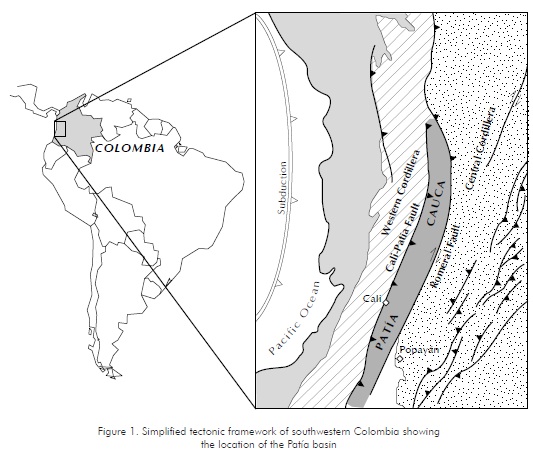
A previous study has analyzed the Matacea Creek oil seep and attempted to assess its origin through the geochemical correlation with organic extracts from a few outcrop samples (Rangel and Giraldo, 1993). The limited number of outcrop samples available, hampered the identification of the source rock and the appraisal of the petroleum potential of this frontier area.
In the present study, a comprehensive set of 70 samples from 6 outcrop sections comprising the potential source rocks was submitted for organic carbon determinations (TOC), Rock-Eval pyrolysis, and visual kerogen analyses. Organic extracts from 18 rock samples, analyzed by gas chromatography and mass spec-trometry (GCMS), were correlated with the oil sample from the Matacea Creek seep. This study shows how a surface geochemical survey can provide information about a petroleum system in a frontier area.
GEOLOGIC FRAMEWORK
The Patía basin (Figure 1) is a narrow intermontane depression about 120 km long and 35 km wide, located approximately between the cities of Popayán and Pasto. The basin is limited to the east by the Romeral Fault and the Central Andean Cordillera, to the west by the Cali-Patía Fault and the Western Andean Cordillera, and to the north by the Popayán basement high, which separates it from the northern part of the Cauca Basin (Etayo et al., 1983).
The Western Cordillera as well as the basement rock of the Patia basin are composed of metamorphosed distal turbiditic deposits of the Dagua Group mixed with ophiolitic fragments of oceanic crust (Alfonso, 1993), relicts of an accretionary complex related to the Mesozoic subduction (Etayo et al., 1982). The Central Cordillera is composed of Paleozoic and Mesozoic crystalline rocks metamorphosed by Mesozoic and Cenozoic plutonisms. A divergent thrusting of Cenozoic age gave rise to an uplifted metamorphic nucleus that encompasses low to medium grade rocks, with fragments of high pressure facies, such as eclogites and glaucophane schists (Irving, 1975; Orrego et al., 1980; Feininger, 1982; MacCourt and Millward, 1983). The Romeral Fault, an important structural discontinuity over 500 km long (Figure 1), separates the metamor-phic rocks of the Central Cordillera from the Mesozoic ophiolitic complex.
The Patia basin infill comprises Upper Cretaceous to Quaternary deposits (Figure 2). The Upper Cretaceous section is mostly composed of siliciclastics and cherts interbedded with volcanic rocks from the Diabasic Group below and with limestones in the Chapungo Sequence, Agua Clara and Río Guabas formations. Conversely, the Cenozoic section is largely composed of conglomerates, sandstones and shales locally in-terbedded with limestones and thin coal levels in the Tertiary formations and with tuffs and pyroclasts in the Late Tertiary and Quaternary units.
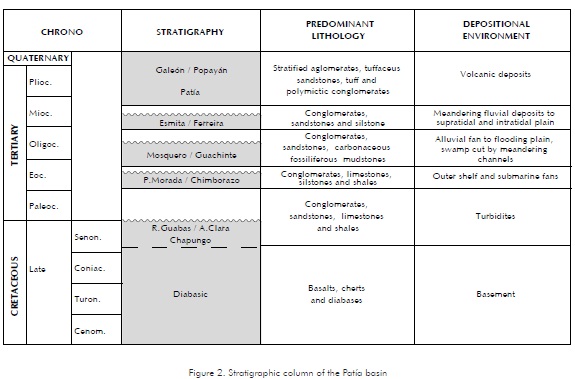
SAMPLES AND METHODS
Geochemical analyses were performed on 70 rock samples from 6 outcrop sections (Figure 3), considered to be representative of the potential source rock units. The number of samples from each stratigraphic unit and their lithologies are presented in Table 1. Analyses were also carried out on an oil sample collected from the seep of the Matacea Creek (Figure 3).
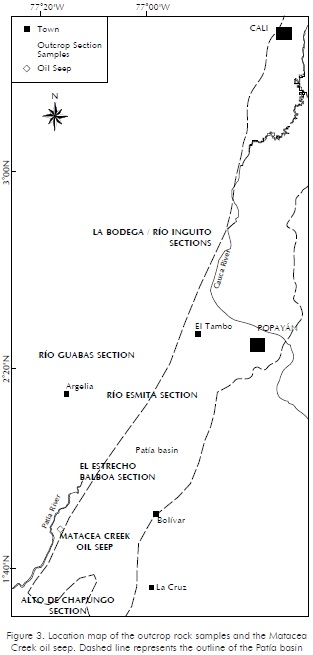

After being with using fresh water and air dried, the rocks samples were powdered, decalcified with HCl (50%) and analyzed using a LECO WR-12 apparatus to determine their organic carbon content (TOC). Py-rolysis analyses were performed with a Rock-Eval II apparatus following the method described by (Espitalié et al., 1985) on samples with TOC contents higher than 0,5%. For the visual kerogen investigation, 26 rock samples were demineralized with HCl and HF. The isolated kerogen samples were mounted on strewn slides to be analyzed with transmitted white light and fluorescence microscopy using a Zeiss Axiophot apparatus. Isolated kerogens were also mounted on plugs to be analyzed with reflected microscopy with a Leitz MVP-SP apparatus.
A set of selected 18 powdered rock samples was submitted to Soxhlet extraction for 24 h using dichloromethane. Saturate, aromatic and NSO compounds fractions of the oil seep sample and the recovered organic extracts from the rocks were eluted from a silica-gel column using n-hexane, n-hexane+toluene and toluene+methanol, respectively. The saturate fractions were analyzed in a Hewlett-Packard 5890-A gas chromatograph (splitless injector and 30-m SPB-TM-1 column), using hydrogen as carrier gas and column temperature programmed from 120° to 310°C at 6°C/min . The same fractions were analyzed using a HP-5972 mass spectrometer detector coupled to a Hewlett-Packard 5890-A gas chromatograph (on-column injector and 30-m HP-5MS column) using helium as carrier gas and column temperature programmed from 70° to 170°C at 20°C/min and from 170° to 310°C at 2°C/min .
RESULTS AND DISCUSSION
Hydrocarbon source potential and thermal maturity of outcrop samples
Total organic carbon (TOC) contents are high (> 2,0%) for most of the samples of the Chapungo Sequence and Río Guabas Formation, moderate (between 1 and 2%) for the Chimborazo and Peña Morada formations, and low (< 1,0%) for the samples of the Agua Clara Formation and Diabasic Group (Figure 4). Good hydrocarbon source yields (S2 > 6 mgHC/gRock) were found only in the Chapungo Sequence (Figure 4). The Chimborazo Formation displays fair source yields (Rock-Eval S2 mostly between 2 and 5 mgHC/gRock), while all the other units present poor yields (lower that 1 mgHC/gRock), including the samples with high TOC values from the Río Guabas Formation (Figure 4).
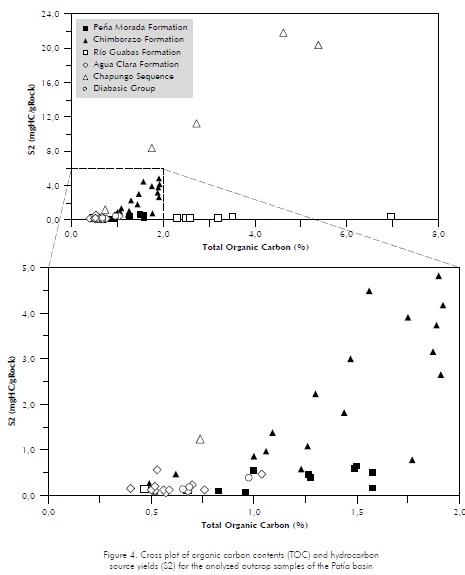
The distribution of the analyzed samples in a modified van Krevelen diagram (Figure 5a) points to a prevalence of type II kerogen in most of the samples of the Chapungo Sequence, while a mixed II-III kerogen type dominates in the Chimborazo Formation. The remaining samples present very low hydrogen indices (HI < 100 mgHC/gTOC). Some of these samples present a moderate to low maturity level (Tmax < 450°C ; Figure 5b), pointing to a dominance of type III kerogen. The majority of the low-HI samples however, have reached a high degree of thermal evolution (Tmax > 460°C ; Figure 5b), which indicates that present HI values do not reflect the original character of these rocks.
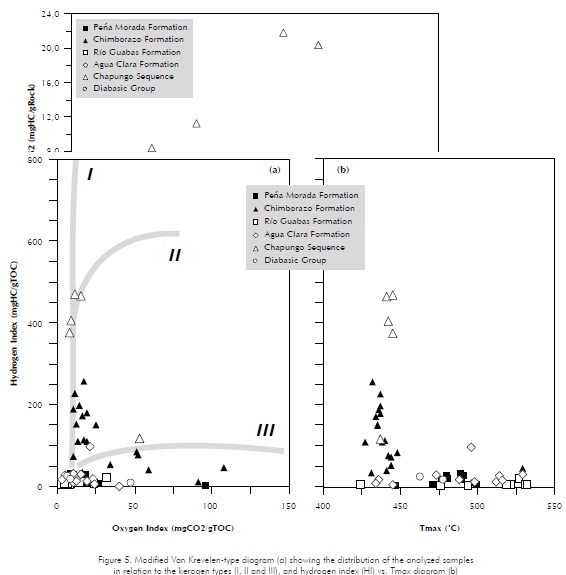
Visual kerogen analyses indicates a dominance of amorphous organic matter (80%) for most of the analyzed samples of the Peña Morada, Chimborazo and Agua Clara formations and Chapungo Sequence (Figure 6). Macerals of the liptinite group were not found, while vitrinite and/or inertinite contents may range from about 40 to 100% in a few samples of the Chimborazo and Agua Clara formations and Diabasic Group, corroborating the pyrolysis results.
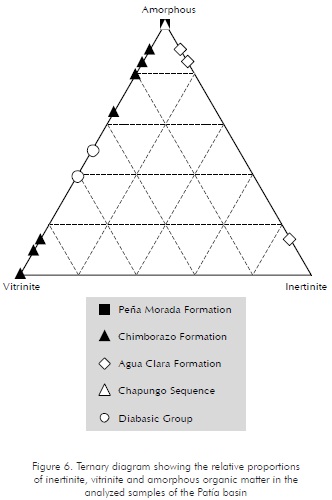
Vitrinite reflectance measurements performed on 13 samples presented a good correlation with Tmax values (Figure 7). Most of the samples display reflectance values between 0,4 and 0,7% Ro, pointing to an immature to marginally level of thermal maturity, whereas some Río Guabas Formation samples reach up to 1,8% Ro, indicating an overmature degree. It is worth mentioning that the vitrinite particles of the overmature samples displays a "cauliflower texture" (Giraldo, B. N., personal communication), considered to be indicative of the rapid escape of volatiles in response to a short time heating event (Taylor et al., 1998). Such feature indicates that the thermal effect of igneous intrusions might have influenced the thermal maturity of such intervals.
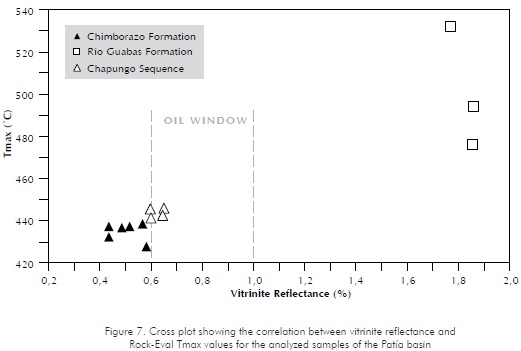
The integration of bulk analyses indicates that the Chapungo Sequence (Late Cretaceous) presents the higher potential to generate liquid hydrocarbons, being followed by the Chimborazo Formation (Eocene). In practically all the studied samples, these units are immature or have reached only the beginning of the "petroleum window" (up to 0,7% Ro). Despite the low HI values presented by the samples of the Río Guabas Formation, the combination of good TOC contents and dominance of amorphous organic matter with high Tmax values suggest that such samples might have originally presented fair to good hydrocarbon source yields.
Geochemical characterization of organic extracts of outcrop samples
A set of 18 samples from the Chapungo Sequence, Peña Morada and Chimborazo formations was selected for Soxlhet extraction. Saturates contents of organic extracts range from 16 to 58%, while the proportion of NSO compounds reaches up to 70% in the low maturity samples. Gas chromatograms of the saturate fractions display differences that reflect both maturity and organic facies variations. The samples of the Peña Morada Formation (GC; Figure 8) and most of the samples of the Chapungo Sequence present pristane/phytane (Pr/Ph) ratios between 1,06 and 1,84, pointing to a prevalence of suboxic to oxic conditions of deposition and a relatively lower contribution of terrestrial plants (Didyk et al., 1978; ten Haven et al., 1988; Mello et al., 1988). Conversely, the samples of the Chimborazo Formation and one sample from the Chapungo Sequence (G-119) shows high Pr/Ph ratios (> 2,5) and bimodal distribution of n-alkanes with high relative abundance of high molecular weight paraffins (> n-C23; Figure 8). Such characteristics indicate the prevalence of a more oxidant environment with an important input of continental organic matter.
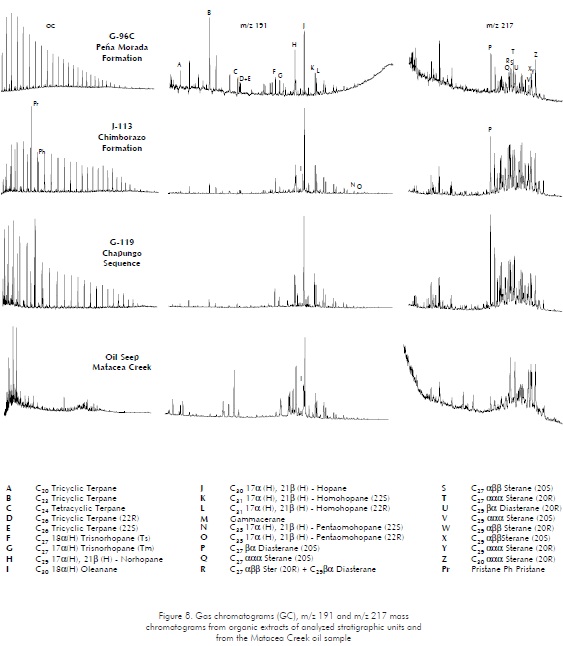
Biomarkers in the Chapungo Sequence and Peña Morada and Chimborazo formations, steranes/hopanes ratios are generally around 0,5, suggesting a significant input of bacterial biomass (Mello et al., 1988; Peters and Moldowan, 1993). Among the steranes (m/z 217; Figure 8), there is a general dominance of the C27 compounds over their C28 and C29 counterparts, although the C29 steranes dominates in some samples of the Chapungo sequence. The relative abundance of dia-steranes is moderate to high (diasterane/sterane ratios mostly equal or higher than 1), indicating a significant siliciclastic input (Mello et al., 1988).
Among the terpanes (m/z 191; Figure 8), C24 tetracyclic/C26 tryciclic terpanes ratios range from 0,6 to 2,8. High relative abundance of C24 tetracyclic terpanes are commonly related to depositional environments with high input of terrestrial plants (Philp and Gilbert, 1986; Abdullah et al., 1988; Isaksen, 1995). The 18K(H) oleanane is present in all samples, with oleanane/hopane ratios bellow 0,1 in the Peña Morada Formation and Chapungo Sequence and up to 0,22 in the Chimborazo Formation. The oleanane is derived from pentacyclic triterpanes found in the angiosperms, being therefore a Late Cretaceous/Tertiary marker for higher plants input (Peters and Moldowan, 1993).
Tricyclic terpanes occur in relative low abundances in the Chimborazo samples (tryciclic/hopanes ratios around 0,4) and low to moderate proportions in the samples of the Chapungo Sequence and Peña Morada Formation (Figure 8). C35/C34 homohopanes ratios ranging between 0,4 and 0,9 indicates an oxic to suboxic condition of sedimentation (Mello et al., 1988; Peters and Moldowan, 1993) and corroborates the interpretation of Pr/Ph ratios. Gammacerane occurs in relative very low abundances in all but three samples of the Chapungo Sequence, with gammacerane/hopane ratios between 0,4 and 0,8. Such high values might be indicative of a high water salinity environment (Moldowan et al., 1985; Mello et al., 1988; ten Haven et al., 1988). Ts/Tm ratios range from 0,6 to 2,6, apparently reflecting both maturity and organic facies variations.
Oil seep geochemistry and oil-source rock correlation
The sample of the oil seep found in the Matacea Creek show a dominance of saturates (over 65%) over aromatics (about 23%) and NSO compounds (around 10%). GC-MS and GC analyses of the saturates fraction revealed the existence of demethylated hopanes and a depletion of medium/high molecular weight n-alkanes (Figure 8), which indicates that the oil seep has been submitted to bidegradation (Peters and Moldowan, 1993). Nevertheless, the combination of such features with the presence of light n-alkanes and the high proportion of saturates might be indicative of a relatively frequent recharge of the seep.
Regarding the biomarkers, the Matacea oil seep is characterized by a very low relative abundance of steranes (steranes/hopanes around 0,1), low proportion of tricyclic terpanes, high C24 tetracyclic/C26 tryciclic terpanes (over 10) and oleanane/hopane (0,38) ratios, low relative abundance of gammacerane and C35 homo-hopanes, moderate to high proportion of diasteranes, dominance of the C29 steranes over their C28 and C27 counterparts, and low sterane isomerization ratios (C29 KKK S/S+R= 0,43 and C29 K22/K22+KKK= 0,47). Such molecular features suggest that such oil is derived from a source rock deposited under proximal marine suboxic conditions that reached a low to moderate level of thermal maturity. Such interpretations must be viewed with caution, since the assessment of source rock environment, age and thermal maturity through oil biomarkers is hampered by the biodegradation. A number of molecular parameters such as the steranes/ hopanes, oleanane/hopane, diasteranes/steranes and C29 KKK S/S+R steranes ratios can be significantly affected (Peter and Moldowan, 1993), depending on the degree of alteration and mixture with late pulses of recharge.
Oil seep biodegradation also hinders the correlation with the organic extracts of the potential source rocks. Despite such limitation, a visual inspection of GC-MS fingerprints (Figure 8) as well as the cross-plots of molecular parameters (Figures 9 and 10) indicates that among the analyzed units the Chimborazo Formation best correlates with the Matacea oil seep. Both the oil and the extracts share a proximal marine suboxic depositional character with evidence of a significant input of terrigenous organic matter. The relatively higher abundance of terrigenous plants markers in the oil seep might be a result of biodegradation or indicate the existence of more proximal (paludal) facies of the Chimborazo Formation, not sampled in this survey.
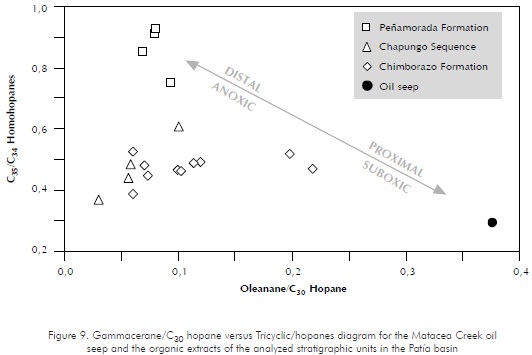
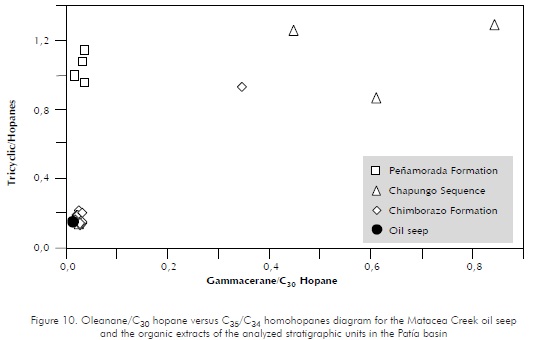
CONCLUSIONS
Bulk analyses indicate that the Chapungo Sequence (Late Cretaceous) presents the higher potential to generate liquid hydrocarbons, followed by the Chimborazo Formation (Eocene). These units are immature or have reached the beginning of the "oil window" (up to 0,7% Ro) in practically all the studied samples. Despite the low HI values presented by the samples of the Río Guabas Formation (Late Cretaceous), the combination of good TOC contents and dominance of amorphous organic matter with high Tmax values suggest that such samples might have originally presented fair to good hydrocarbon source yields. Petrographic evidence suggests that the heat effect of igneous intrusions account for the high maturity of some of the sampled intervals.
-
Biomarker characteristics of analyzed samples indicate that the Chapungo Sequence was deposited in a marine suboxic environment with variable siliciclastic input and water salinity, the Peña Morada Formation under more anoxic conditions, and the Chimborazo Formation in a proximal suboxic marine environments with an important contribution of terrigenous organic matter. Bulk and molecular parameters indicate that Matacea Creek seep has been biodegraded, but there is also evidence of a relatively continuous recharge of the oil at the surface. Biomarker features suggest that the oil is derived from a source rock deposited under proximal marine suboxic conditions and that reached a moderate to low degree level of thermal maturity.
-
Although oil seep biodegradation hampers the comparison with the organic extracts, biomarker data indicates that the Chimborazo Formation presents the best correlation with the Matacea oil seep among the analyzed units. The lack of a perfect match between the oil seep and the Chimborazo extracts might be the result of biodegradation or the existence of more proximal facies of the Chimborazo Formation, not sampled in this survey.
ACKNOWLEDGMENTS
The authors extend their appreciation to Ecopetrol for permitting the publication of the results of this study, to the geologist Blanca N. Giraldo for the visual kero-gen analyses, to the geologists Pedro Parra and César Mora for the thoughtful discussions, to the laboratory personnel of the Geochemistry Group of the Colombian Petroleum Institute (ICP) for the analytical support, and to the geologist Leslie B. Magoon for his thoughtful review and comments.
REFERENCES
Abdulah, W. H., Murchinson, D., Jones, J. M.; Telnaes, N. and Gjelberg, J., 1988. "Lower carboniferous coal depositional environments on Spitsbergen, Svalbard". In: L. Mattavelli and L. Novelli, Advances in Organic Geochemistry: 953-964. [ Links ]
Alfonso, C. A., 1993. "Late tertiary structure of the Valle del Cauca basin, Colombia, Andes". Ph.D. Thesis, University of South Carolina, 254pp. [ Links ]
Didyk, B. M., Simoneit, B. R. T., Brassel, S. C. and Eglinton, G., 1978. "Organic geochemical indicators of paleoenvironmental conditions of sedimentation". Nature, 272, 216-222. [ Links ]
Espitalié, J., Deroo, G. and Marquis, F., 1985. "La pyrolise Rock-Eval et ses applications". Revue de l'Institute Français du Pétrole, 40: 563-579. [ Links ]
Etayo-Serna, F., Parra, E. and Rodríguez, G., 1982. "Análisis facial del Grupo Dagua con base en secciones aflorantes al oeste de Toro (Valle del Cauca)". Geología Norandina, 5: 3-12. [ Links ]
Etayo-Serna, F. et al., 1983. "Mapa de terrenos geológicos de Colombia". Publicación Especial Ingeominas, 14, 235p. [ Links ]
Feininger, T., 1982. "The metamorphic basement of Ecuador". Geological Society of America Bulletin, 93(1): 87-92. [ Links ]
Irving, E., 1975. "Structural evolution of the northernmost Andes, Colombia". US Geological Survey Professional Paper, 846, 42 pp. [ Links ]
Isaksen, G. H., 1995. "Organic geochemistry of paleodepositional environments with a predominance of terrigenous higher-plant organic matter". In: A. Y. Huc, Paleogeography, Paleoclimate and Source Rocks, AAPG Studies in Geology, No. 40: 81-104. [ Links ]
McCourt, W. J. and Millward, D., 1983. "Fallas principales de acreción de las placas en el Valle del Cauca, Suroccidente de Colombia". IV Congreso Colombiano de Geología, Cali, 7 p. [ Links ]
Mello, M. R., Telnaes, N., Gaglianone, P. C., Chicarelli, M. I., Brassel, S. C. and Maxwell, J. R., 1988. "Organic geochemical characterization of depositional environments of source rocks and oils in Brazilian marginal basins". Organic Geochemistry, 13: 31-45. [ Links ]
Moldowan, J. M.; Seifert, W. K. and Gallegos, E. J., 1985. "Relationship between petroleum composition and depositional environment of petroleum source rocks". American Association of Petroleum Geologists Bulletin, 69: 1255-1268. [ Links ]
Orrego, A., Cepeda, H. and Rodríguez, G., 1980. "Esquistos glaucafánicos en el área de Jambaló, Cauca (Colombia)". Geología Norandina, 1: 5-10. [ Links ]
Peters, K. E. and Moldowan, J. M., 1993. "The biomarker guide: interpreting molecular fossils in petroleum and ancient sediments". New Jersey, Prentice-Hall, 363pp. [ Links ]
Philp, R. P. and Gilbert, T. D., 1986. "Biomarker distributions in Australian oils predominantly derived from terrigenous source material". Organic Geochemistry, 10: 73-84. [ Links ]
Rangel, A. V. and Giraldo, B. N., 1993. "Evaluación geoquímica de afloramientos de la subcuenca de Patía". Memorias del VI Congreso Colombiano de Geología, Medellín, p. 354-369. [ Links ]
Taylor, G. H., Teichmüller, M., Davis, A., Diessel, C. F. K., Littke, R. and Robert, P., 1998. "Organic Petrology". Berlin, Gebrüder Borntraeger, p. 532-535. [ Links ]
ten Haven, H. L., De Leeuw, J. W., Rullkötter, J. and Sinninghe Damste, J. S., 1988. "Application of biological markers in the recognition of paleohypersaline environments". In: Lacustrine petroleum source rocks (Edited by Fleet A. J., Kelts K., Talbot M. R.), Geological Society Special Publication, 40: 3-26. [ Links ]














